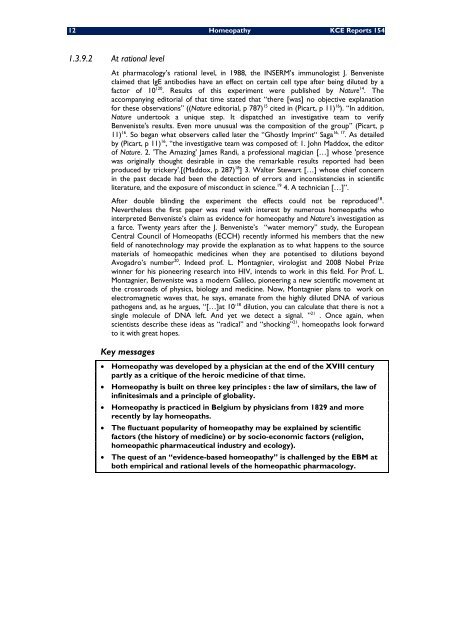Etat des lieux de l'homéopathie en Belgique - KCE
Etat des lieux de l'homéopathie en Belgique - KCE
Etat des lieux de l'homéopathie en Belgique - KCE
You also want an ePaper? Increase the reach of your titles
YUMPU automatically turns print PDFs into web optimized ePapers that Google loves.
12 Homeopathy <strong>KCE</strong> Reports 154<br />
1.3.9.2 At rational level<br />
At pharmacology’s rational level, in 1988, the INSERM’s immunologist J. B<strong>en</strong>v<strong>en</strong>iste<br />
claimed that IgE antibodies have an effect on certain cell type after being diluted by a<br />
factor of 10 120 . Results of this experim<strong>en</strong>t were published by Nature 14 . The<br />
accompanying editorial of that time stated that “there [was] no objective explanation<br />
for these observations” ((Nature editorial, p 787) 15 cited in (Picart, p 11) 16 ). “In addition,<br />
Nature un<strong>de</strong>rtook a unique step. It dispatched an investigative team to verify<br />
B<strong>en</strong>v<strong>en</strong>iste's results. Ev<strong>en</strong> more unusual was the composition of the group” (Picart, p<br />
11) 16 . So began what observers called later the “Ghostly Imprint“ Saga 16, 17 . As <strong>de</strong>tailed<br />
by (Picart, p 11) 16 , “the investigative team was composed of: 1. John Maddox, the editor<br />
of Nature. 2. 'The Amazing' James Randi, a professional magician […] whose 'pres<strong>en</strong>ce<br />
was originally thought <strong><strong>de</strong>s</strong>irable in case the remarkable results reported had be<strong>en</strong><br />
produced by trickery'.[(Maddox, p 287) 18 ] 3. Walter Stewart […] whose chief concern<br />
in the past <strong>de</strong>ca<strong>de</strong> had be<strong>en</strong> the <strong>de</strong>tection of errors and inconsist<strong>en</strong>cies in sci<strong>en</strong>tific<br />
literature, and the exposure of misconduct in sci<strong>en</strong>ce. 19 4. A technician […]”.<br />
After double blinding the experim<strong>en</strong>t the effects could not be reproduced 18 .<br />
Nevertheless the first paper was read with interest by numerous homeopaths who<br />
interpreted B<strong>en</strong>v<strong>en</strong>iste’s claim as evi<strong>de</strong>nce for homeopathy and Nature’s investigation as<br />
a farce. Tw<strong>en</strong>ty years after the J. B<strong>en</strong>v<strong>en</strong>iste’s “water memory” study, the European<br />
C<strong>en</strong>tral Council of Homeopaths (ECCH) rec<strong>en</strong>tly informed his members that the new<br />
field of nanotechnology may provi<strong>de</strong> the explanation as to what happ<strong>en</strong>s to the source<br />
materials of homeopathic medicines wh<strong>en</strong> they are pot<strong>en</strong>tised to dilutions beyond<br />
Avogadro’s number 20 . In<strong>de</strong>ed prof. L. Montagnier, virologist and 2008 Nobel Prize<br />
winner for his pioneering research into HIV, int<strong>en</strong>ds to work in this field. For Prof. L.<br />
Montagnier, B<strong>en</strong>v<strong>en</strong>iste was a mo<strong>de</strong>rn Galileo, pioneering a new sci<strong>en</strong>tific movem<strong>en</strong>t at<br />
the crossroads of physics, biology and medicine. Now, Montagnier plans to work on<br />
electromagnetic waves that, he says, emanate from the highly diluted DNA of various<br />
pathog<strong>en</strong>s and, as he argues, “[…]at 10 -18 dilution, you can calculate that there is not a<br />
single molecule of DNA left. And yet we <strong>de</strong>tect a signal. ” 21 . Once again, wh<strong>en</strong><br />
sci<strong>en</strong>tists <strong><strong>de</strong>s</strong>cribe these i<strong>de</strong>as as “radical” and “shocking” 21 , homeopaths look forward<br />
to it with great hopes.<br />
Key messages<br />
• Homeopathy was <strong>de</strong>veloped by a physician at the <strong>en</strong>d of the XVIII c<strong>en</strong>tury<br />
partly as a critique of the heroic medicine of that time.<br />
• Homeopathy is built on three key principles : the law of similars, the law of<br />
infinitesimals and a principle of globality.<br />
• Homeopathy is practiced in Belgium by physicians from 1829 and more<br />
rec<strong>en</strong>tly by lay homeopaths.<br />
• The fluctuant popularity of homeopathy may be explained by sci<strong>en</strong>tific<br />
factors (the history of medicine) or by socio-economic factors (religion,<br />
homeopathic pharmaceutical industry and ecology).<br />
• The quest of an “evi<strong>de</strong>nce-based homeopathy” is chall<strong>en</strong>ged by the EBM at<br />
both empirical and rational levels of the homeopathic pharmacology.

















